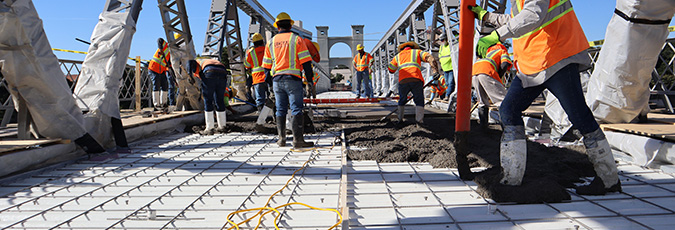Fiber Reinforced Polymers (FRP) are a popular composite material made of glass fiber and resin used widely in various industries like metal processing, wastewater treatment, and construction. They are made of a polymer matrix reinforced with fibers. FRP composites differ from traditional construction materials, like steel or aluminum, as FRP composites are anisotropic, meaning their mechanical properties are in the direction of fiber placement.
Because the glass fibers can be arranged continuously, woven, or chopped, each configuration provides a unique strength reinforcement, density, and weight.
These characteristics make composite building materials ideal for construction thanks to their optimal strength-to-weight ratio, advanced durability, corrosion resistance, and affordability.
Applications of FRP in Construction
FRP is an ideal material for construction because of its many applications. Some of the most common ways FRP is utilized in the construction industry include:
- Reinforcing and strengthening concrete structures
- Repairing damaged structures
- Retrofitting buildings for seismic resistance
- Use in bridge decks, columns, beams, and other structural elements
FRP offers the usual benefits of traditional building materials with additional superior qualities.
What are the benefits of choosing FRP for your construction project?
Advantages of FRP in Construction
FRP is built to thrive in challenging conditions and will do so consistently without a hefty price tag. Traditional materials have higher maintenance costs, less flexibility, and are less corrosion-resistant when exposed to extreme elements. With FRP applications, you’re getting the most bang for your buck, as many FRP materials can perform for nearly 75 years with little to no maintenance.
Not only does FRP offer longevity, but its dynamic nature also allows for some design capabilities. While other building materials may require paint or other coatings, FRP has various resin options that can be customized to fit your needs. FRP can work for nearly any construction project, even being able to retrofit existing structures.
Limitations of FRP in Construction
While FRP is versatile and can offer many benefits to replace wood, metal, concrete, or plastic in various building applications, some limitations depend on your project.
- Cost: At first glance, FRP materials may appear to have a higher price than other materials, like steel, but when you consider installation, handling, transportation, and maintenance costs, you’re looking at lower expenses with FRP.
- Fire resistance: FRP materials' temperature/fire resistance level largely depends upon the resin mixture. However, FRP materials generally are combustible and have poor long-term temperature resistance.
- Design challenges: One of the most significant advantages of FRP is its ability to be engineered to meet nearly any construction parameters, like custom dimensions and specific load-bearing capabilities; however, they usually require a custom approach.
For most projects, the pros outweigh the cons. However, if you’re unsure that FRP is the best match for your construction project, we recommend speaking with one of our team members to learn about similar applications and projects we’ve fulfilled.
Best Practices for Using FRP in Construction
Enduro is passionate about being an active member of the composites industry, and we understand that implementing FRP into construction applications requires various steps to achieve the full benefits of FRP composites.
When using FRP in construction, it’s crucial that you work with experienced engineers and contractors that follow proper installation techniques and that you stay on top of all maintenance and inspection schedules.
Many of Enduro’s products meet a variety of standards, approvals, listings, and certifications, and several of our team members hold board or membership positions with committees such as the ACMA (American Composite’s Manufacturer’s Association) and the ASCE (American Society of Civil Engineers). Enduro knows the ins and outs of FRP best practices, and one of our reps would be happy to discuss your needs or walk you through potential solutions.
Future of FRP in Construction
FRP materials are the superior choice for construction projects regarding challenging conditions and harsh environments. FRP is naturally corrosion-resistant and has several types of polymer available, which can customize resistance to any harsh environmental exposure.
The flexibility in design and components makes FRP a cost-efficient and practical option for the construction industry. While FRP has been widely utilized in the construction industry since the early ’90s, its many advantages and design capabilities have made it the go-to option for residential and commercial construction projects. FRP materials consistently undergo comprehensive and rigorous testing to detect and assess areas for improvement.
FRP Materials in Construction
Technological advancements and design flexibility continue to push FRP’s popularity within the construction sector. Although FRP offers distinct advantages as a premium material for construction, it is crucial that you enlist the guidance of experienced professionals.
Contact one of our sales reps to ensure that your project has the materials that fit your needs and specifications.
Contact Enduro Composites for Advanced Construction Materials
If you’re unsure that FRP is the right choice for your industry or you’re concerned about switching materials, look through our case studies to get a better idea of how our engineers can craft unique solutions. We have engineered, manufactured, and installed many custom FRP products for our customers.

